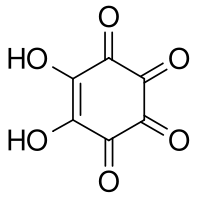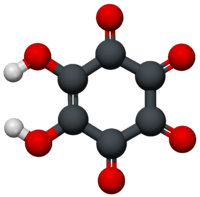Rhodizonic acid
 | |
 | |
| Names | |
|---|---|
| IUPAC name
5,6-dihydroxycyclohex-5-ene-1,2,3,4-tetrone | |
| Other names
dihydroxydiquinoyl dioxydiquinone | |
| Identifiers | |
| |
| 3D model (JSmol) |
|
| ChemSpider | |
| ECHA InfoCard | 100.003.888 |
| EC Number | 204-276-5 |
| MeSH | C005690 |
| PubChem CID |
|
| |
| |
| Properties | |
| C6H2O6 | |
| Melting point | 130 to 132 °C (266 to 270 °F; 403 to 405 K) |
| Except where otherwise noted, data are given for materials in their standard state (at 25 °C [77 °F], 100 kPa). | |
| | |
| Infobox references | |
Rhodizonic acid is a chemical compound with formula C6H2O6 or (CO)4(COH)2. It can be seen as a two-fold enol and four-fold ketone of cyclohexene, more precisely 5,6-dihydroxycyclohex-5-ene-1,2,3,4-tetrone.
Rhodizonic acid is usually obtained in the form of a colorless "dihydrate" C6H2O6·2H2O. The latter is actually 2,3,5,5,6,6-hexahydroxycyclohex-2-ene-1,4-dione, where two of the original ketone groups are replaced by two pairs of geminal diols. The orange to deep-red and highly hygroscopic anhydrous acid can be obtained by low-pressure sublimation of the dihydrate.[1][2]
Like many other enols, rhodizonic acid can lose the hydrogen cations H+ from the hydroxyls (pK1 = 4.378 ± 0.009, pK2 = 4.652 ± 0.014 at 25 °C),[3] yielding the hydrogenrhodizonate anion C6HO6− and the rhodizonate anion C6O62−. The latter is aromatic and symmetric, as the double bond and the negative charges are delocalized and evenly distributed over the six CO units. Rhodizonates tend to have various shades of red, from yellowish to purplish.
Rhodizonic acid has been used in chemical assays for barium, lead, and other metals.[4] In particular, the sodium rhodizonate test can be used to detect gunshot residue (which contains lead) in a subject's hands,[5] and to distinguish arrow wounds from gunshot wounds for hunting regulation enforcement.[6]
History
Rhodizonic acid was discovered by Austrian chemist Johann Heller in 1837, by analyzing the products of heating a mixture of potassium carbonate and charcoal.[7][8][9] For a while, rhodizonates were believed to have the formula C7O7 · Me3.[10] The name comes from Greek ῥοδίζω (rhodizō, "to tinge red"),[11] on account of the color of its salts.
Chemistry
Salts
Rhodizonates tend to have various shades of red, from yellowish to purplish, in transmitted light, with a greenish luster in reflected light.
Potassium rhodizonate can be prepared with good yield and purity by oxidizing inositol with nitric acid and reacting the result with potassium acetate in the presence of oxygen. The rhodizonate crystallizes out of the solution due to its relative insolubility in water.[12]
Sodium rhodizonate is dark brown and stable when dry,[13] but the aqueous solution decomposes in a few days, even in the refrigerator.[4] Lead rhodizonate is dark violet.[13][14]
Oxidation and decomposition
Rhodizonic acid is a member of a chain of oxidation products: benzenehexol (COH)6, tetrahydroxybenzoquinone (THBQ) (COH)4(CO)2, rhodizonic acid (COH)2(CO)4, and cyclohexanehexone (CO)6.[4] Lithium rhodizonate, together with salts of THBQ and benzenehexol, has been considered for possible use in rechargeable electrical batteries.[15] The monovalent anion C
6O−
6 has been detected in mass spectrometry experiments.[16]
Rhodizonic acid and the rhodizonate anion can lose one of the CO units to yield croconic acid (CO)3(COH)2 and the croconate anion C5O52−, respectively, by mechanisms that are still imperfectly known. In basic solutions (pH > 10), rhodizonic acid quickly converts to the THBQ anion (CO)64− in the absence of oxygen, and to croconic acid in its presence. At pH 8.3 and exposure to light, solutions are stable for days in the absence of oxygen, and decompose to croconic acid and other products (possibly including cyclohexanehexone or dodecahydroxycyclohexane) in its presence.[17][18]
Structure
Acid
In solution, the acid and the hydrogenrhodizonate ion are mostly hydrated, with some of the ketone groups C=O replaced by geminal hydroxyls, C(OH)2[3]
Salts
In anhydrous rubidium rhodizonate 2Rb+ · C6O62−, the rhodizonate anions are stacked in parallel columns, and so are the rubidium ions. In the plane perpendicular to the columns, these are arranged as two interleaved hexagonal grids. The anions are planar.[2]
Anhydrous potassium rhodizonate 2K+ · C6O62− has a distinct but similar structure. The anions and cations are arranged in alternate planes. Within each plane, the anions are arranged in an hexagonal grid. Each K ion is arranged so that it connects symmetrically to eight oxygens of four anions, two from each adjacent plane. The anions are slightly twisted in the "boat" shape (with 0.108 Å of rms deviation from mean plane).[19] Sodium rhodizonate 2Na+ · C6O62− has the same structure, with slightly more distorted anions (0.113 Å rms)[20]
In solution, the rhodizonate anion is not hydrated.[3]
See also
- Acetylenediol (COH)2
- Deltic acid (CO)(COH)2
- Squaric acid (CO)2(COH)2
- Croconic acid (CO)3(COH)2
References
- ↑ Elizabeth Patton, Robert West (1970), New aromatic anions. VIII. Acidity constants of rhodizonic acid. J. Phys. Chem., volume 74 issue 12, pp 2512–2518. doi:10.1021/j100706a018
- 1 2 Dario Braga, Gianna Cojazzi, Lucia Maini and Fabrizia Grepioni (2001), Reversible solid-state interconversion of rhodizonic acid H2C6O6 into H6C6O8 and the solid-state structure of the rhodizonate dianion C6O62 – (aromatic or non-aromatic?). New J. Chem., volume 25, pages 1221 - 1223. doi:10.1039/b107317f
- 1 2 3 R. I. Gelb, L. M. Schwartz, D. A. Laufer (1978), The structure of aqueous rhodizonic acid. J. Phys. Chem., volume 82 issue 18, pp. 1985–1988. doi:10.1021/j100507a006
- 1 2 3 Robert A. Chalmers and Geoffrey M. Telling (1967), A reassessment of rhodizonic acid as a qualitative reagent. Microchimica Acta, Volume 55, Number 6, pages 1126-1135. doi:10.1007/BF01225955
- ↑ Vincent J. M. Di Maio, Gunshot wounds: practical aspects of firearms, ballistics, and forensic techniques, 2nd edition. CRC, 1998. ISBN 0-8493-8163-0. p. 341.
- ↑ Ronald L. Glover (1981), Detecting Lead in "Arrow" Wounds in Deer Using Rhodizonic Acid Wildlife Society Bulletin, Vol. 9, No. 3, pp. 216-219. Online version accessed on 2009-07-30.
- ↑ Johann Florian Heller (1837), Die Rhodizonsäure, eine aus den Produkten der Kaliumbereitung gewonnene neue Säure, und ihre chemischen Verhältnisse, Justus Liebigs Annalen der Pharmacie, volume 24, issue 1, pp. 1–16. Online version accessed on 2009-07-08.
- ↑ Edward Turner, William Gregory, Edward Andrew Parnell, Justus Liebig, James Blythe Rogers (1846), Elements of chemistry. Thomas, Cowperthwait & Co. Online version accessed on 2009-07-30. "When potassium is heated in carbonic acid gas, combination takes place, and a dark olive powder is formed, composed of carbonic oxide and potassium, in the proportion C7O7+K3, or 7CO+3K. This substance is formed in large quantity in the preparation of potassium from carbonate of potash and charcoal, and is the source of great loss and inconvenience. No such compound is formed with sodium, for which reason that metal may be more cheaply prepared than potassium."
- ↑ Carl Löwig (1839), Chemie der organischen Verbindungen. F. Schultess, Zürich.
- ↑ Carl Löwig, Daniel Breed Principles of organic and physiological chemistry. Online version accessed on 2009-07-30.
- ↑ Robert Hunter and Charles Morris (1900), Universal dictionary of the English language. Collier, NY. Online version accessed on 2009-08-07.
- ↑ Paul W. Preisler and Louis Berger (1942), Preparation of Tetrahydroxyquinone and Rhodizonic Acid Salts from the Product of the Oxidation of Inositol with Nitric Acid. Journal of the American Chemical Society, volume 64 issue 1, pp 67–69. doi:10.1021/ja01253a016
- 1 2 Fritz Feigl, Ralph E. Oesper, Spot tests in organic analysis. Online version accessed on 2009-07-30.
- ↑ Leopold Gmelin, Henry Watts (1856), Hand-book of Chemistry. Cavendish Society
- ↑ Haiyan Chen, Michel Armand, Matthieu Courty, Meng Jiang, Clare P. Grey, Franck Dolhem, Jean-Marie Tarascon, and Philippe Poizot (2009), Lithium Salt of Tetrahydroxybenzoquinone: Toward the Development of a Sustainable Li-Ion Battery J. Am. Chem. Soc., 131 (25), pp. 8984–8988 doi:10.1021/ja9024897
- ↑ Richard B. Wyrwas and Caroline Chick Jarrold (2006), Production of C6O6- from Oligomerization of CO on Molybdenum Anions. J. Am. Chem. Soc. volume 128 issue 42, pages 13688–13689. doi:10.1021/ja0643927
- ↑ G. Iraci and M. H. Back (1988), The photochemistry of the rhodizonate dianion in aqueous solution. Canadian Journal of Chemistry, volume 66, page 1293. Online version accessed on 2009-08-07.
- ↑ B. Zhao and M. H. Back (1991), The photochemistry of the rhodizonate dianion in aqueous solution. Canadian Journal of Chemistry, volume 69, page 528. Online version accessed on 2009-08-07.
- ↑ J. A. Cowan and J. A. K. Howard (2004), Dipotassium rhodizonate. Acta Crystallographica, volume E60, pages m511-m513. doi:10.1107/S160053680400529X
- ↑ R. E. Dinnebier, H. Nuss and M. Jansen (2005), Disodium rhodizonate: a powder diffraction study. Acta Crystallographica, volume E61, pages m2148-m2150. doi:10.1107/S1600536805030552